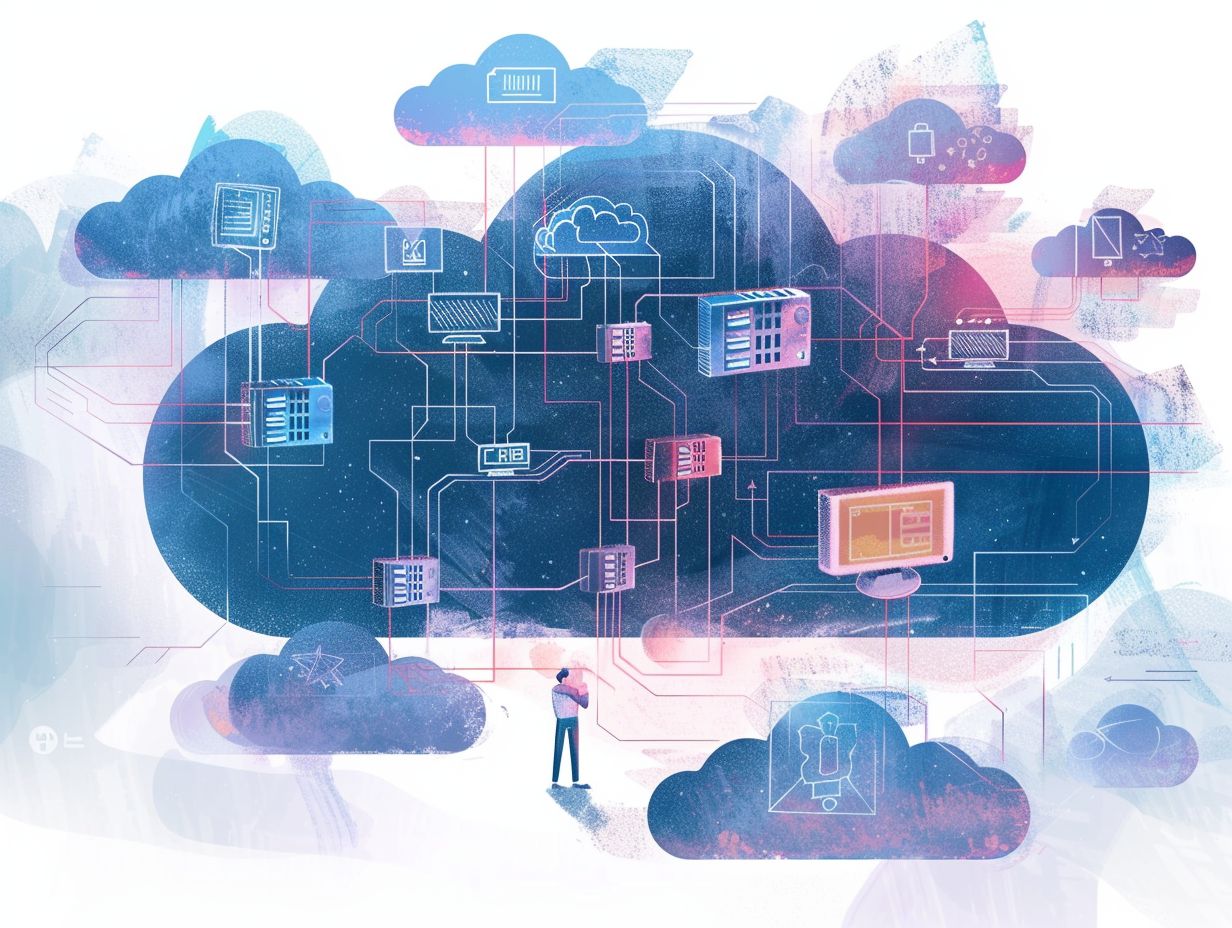In the contemporary digital landscape, cloud environments hold a pivotal role in the prosperity of businesses. Despite the advantages brought by cloud services, they also present numerous challenges that require attention. This article delves into prevalent issues, troubleshooting approaches, and optimal practices for sustaining a robust cloud environment. By comprehending these fundamental facets and leveraging appropriate tools and methodologies, businesses can guarantee the seamless functioning of their cloud infrastructure.
Key Takeaways:

Understanding the Importance and Benefits
Cloud monitoring plays a crucial role in ensuring the optimal performance of IT infrastructures, enabling organizations to deliver exceptional end-user experiences across on-premises, hybrid, and cloud-hosted resources. This constant surveillance is essential for promptly identifying and remedying network bottlenecks, server downtime, or application errors that could potentially disrupt user experiences.
By monitoring key performance indicators such as latency, throughput, and error rates, organizations can proactively address issues before they escalate, thus safeguarding seamless digital interactions. User-centric metrics, such as response time and overall application usability, are meticulously tracked through cloud monitoring solutions to guarantee that digital services meet the demands of today’s dynamic users.
Ultimately, the reliance on cloud monitoring is integral for maintaining a competitive edge in the modern digital landscape.
Common Issues in Cloud Environments
Common issues in cloud environments often revolve around performance bottlenecks, scalability challenges, and security vulnerabilities that can impact the efficiency and scalability of IT infrastructures. Organizations face network traffic issues, configuration management complexities, and a lack of visibility into incidents that affect user experience and service delivery.
These challenges are further compounded by the constant evolution of security threats in the digital landscape. The dynamic nature of cyber attacks makes it difficult for organizations to stay one step ahead, leading to potential data breaches and sensitive information leaks. Scalability concerns also play a significant role, as organizations struggle to efficiently scale their operations in response to changing demands without compromising performance.
Finding the right balance between security measures and performance optimization remains a constant struggle for IT teams striving to maintain a secure and efficient cloud environment.
Identifying and Addressing Common Problems
Efficiently identifying and addressing common problems in cloud environments requires you to adopt a comprehensive approach that integrates performance monitoring, infrastructure optimization, and strategic utilization of monitoring tools and applications. By conducting an analysis of data, resources, and network traffic patterns, your organization can proactively address scalability issues, enhance incident visibility, and implement automation strategies to enhance observability and cloud-based alert mechanisms.
This proactive approach will give the power to your organization to stay ahead in managing its cloud infrastructures effectively. Performance monitoring will provide real-time insights into system health and usage, ensuring smooth operations. Additionally, infrastructure optimization will ensure that resources are utilized efficiently, leading to cost minimization and performance maximization. By leveraging strategic monitoring tools and applications, you will enhance the detection of anomalies and potential risks, enabling swift resolution of issues. Lastly, implementing robust automation strategies will not only save time but also reduce manual errors, fostering reliability and scalability in the cloud environment.
Tools and Techniques for Monitoring Cloud Environments

Monitoring your cloud environments effectively requires a diverse array of tools and techniques tailored to capture and analyze performance metrics, logs, and configuration management data. Utilizing distributed tracing mechanisms, service mesh implementations, and synthetic testing frameworks like Kentik enables organizations to access a variety of monitoring solutions for troubleshooting issues, optimizing performance, and delivering an exceptional user experience.
Tools such as Datadog and AppDynamics provide real-time insights into system performance, allowing for the identification of potential bottlenecks and enhancement of scalability. By vigilantly monitoring critical metrics such as CPU usage, memory consumption, and network traffic, your teams can proactively address any deviations and maintain peak cloud performance.
Furthermore, log analysis is pivotal in identifying anomalies and security threats, guaranteeing data integrity and compliance with industry regulations. Configuration management data facilitates consistency maintenance and update management throughout the cloud infrastructure, streamlining operations and reinforcing system reliability.
Overview of Monitoring Tools and Best Practices
An overview of monitoring tools and best practices for cloud environments involves understanding the key metrics, alerts, and notifications that drive efficient performance management. Tools such as Datadog, AppDynamics, and New Relic provide insights into infrastructure performance, user experience, and security, while best practices emphasize automation, optimization, and growth strategies to enhance scalability and cost-efficiency.
These tools play a critical role in continually monitoring the health and functionality of cloud resources, enabling proactive identification of potential issues before they affect operations. By utilizing metrics related to resource utilization, response times, and error rates, organizations can optimize their cloud environments for peak performance.
Alerts and notifications function as early warning systems, notifying IT teams of deviations from performance benchmarks. The implementation of automation capabilities streamlines processes like dynamically provisioning resources, scaling applications according to demand, and ensuring regulatory compliance.
Through the integration of these tools with best practices, businesses can foster innovation, enhance customer satisfaction, and attain sustainable growth in their cloud operations.
Troubleshooting Strategies for Cloud Environments
Troubleshooting strategies for cloud environments in your organization involve effective techniques for identifying, diagnosing, and resolving performance issues, security vulnerabilities, and scalability challenges. By leveraging cloud monitoring tools, you can implement best practices for incident management, log aggregation, and distributed tracing to ensure optimal performance and user experience.
Incident management plays a crucial role in responding to and resolving system anomalies in cloud environments. It involves swiftly detecting, analyzing, and addressing any disruptions to ensure minimal impact on operations. Log aggregation allows for the consolidation of log data from multiple sources, enabling easy access to crucial information for troubleshooting. Distributed tracing helps in tracking the flow of requests across various microservices, aiding in pinpointing performance bottlenecks and enhancing the overall system efficiency.
Effective Troubleshooting Techniques
Effective troubleshooting techniques for cloud environments entail a systematic approach to identifying root causes, analyzing metrics and logs, and implementing corrective actions. By integrating automation, alerts, and notifications, you can streamline the troubleshooting process, optimize resource utilization, and enhance the overall efficiency and scalability of your cloud-based infrastructures.
Automation is pivotal in this process as it automates routine tasks, facilitating rapid responses to issues and reducing human error. Alerts serve as early warning signals, alerting administrators to potential issues before they escalate. Analyzing relevant metrics aids in gaining insights into system performance, recognizing patterns, and making well-informed decisions. This method ensures expedited incident resolution and fosters continuous optimization of cloud resources for cost-efficiency and performance enhancement.
Best Practices for Maintaining a Healthy Cloud Environment

Implementing best practices for maintaining a healthy cloud environment involves proactive measures aimed at preventing performance issues, enhancing security, and optimizing resource utilization. By focusing on automation, observability, and strategic growth strategies, you can ensure cost-efficient operations, improved user experience, and sustainable scalability in your cloud infrastructure.
Automation plays a crucial role in streamlining repetitive tasks, minimizing human errors, and scaling operations seamlessly. Through automated processes for deployment, monitoring, and scaling, organizations can achieve higher efficiency and agility in managing their cloud environments.
Prioritizing observability enables real-time monitoring, troubleshooting, and optimization of cloud services, ensuring smooth performance and quick issue resolution. Embracing growth strategies involves continually evaluating and adapting cloud resources to align with changing business needs, driving innovation, and staying competitive in today’s dynamic digital landscape.
Proactive Measures for Preventing Issues
Implement proactive measures to prevent issues in your cloud environments. Strategic utilization of automation, alert mechanisms, and training initiatives is essential for optimizing performance, enhancing security, and facilitating growth. By utilizing monitoring tools such as Datadog, Grafana, and Prometheus, your organization can establish a strong foundation for effective optimization, incident response, and cost management to maintain healthy cloud operations.
Integrating these monitoring tools with advanced training strategies on cloud architecture and security best practices give the power tos your teams to proactively identify vulnerabilities and address them before they escalate. Continuous training and upskilling are crucial to ensure that your personnel remain proficient in handling evolving threats and technologies within cloud environments. Automation plays a key role in streamlining routine procedures, reducing the likelihood of human error, while real-time alerts promptly notify administrators of any anomalies or potential security breaches, enabling swift mitigation actions.
Frequently Asked Questions
What is the purpose of monitoring and troubleshooting cloud environments?
The purpose of monitoring and troubleshooting cloud environments is to ensure the smooth and efficient operation of cloud-based systems, identify and resolve any issues that may arise, and optimize performance to meet business needs.
What tools are commonly used for monitoring and troubleshooting cloud environments?

Some commonly used tools for monitoring and troubleshooting cloud environments include cloud management platforms, monitoring software, log management tools, and network and application performance monitoring tools.
How can I proactively monitor my cloud environment?
To proactively monitor your cloud environment, you can set up automated alerts and notifications for any potential issues or anomalies, regularly review performance metrics, and conduct regular health checks on your system.
What are some common challenges faced when troubleshooting cloud environments?
Some common challenges when troubleshooting cloud environments include identifying the root cause of an issue, managing complex and dynamic systems, and ensuring compatibility and integration between various cloud services and applications.
How can I troubleshoot performance issues in my cloud environment?
To troubleshoot performance issues in your cloud environment, it is important to regularly monitor performance metrics, analyze logs and data, and use performance testing tools to identify any bottlenecks or areas for improvement.
What steps should I take to troubleshoot a network connectivity issue in my cloud environment?
If you are experiencing network connectivity issues in your cloud environment, you can start by checking your network configuration, reviewing your firewall and security settings, and conducting a network diagnostic test to pinpoint the source of the problem.
